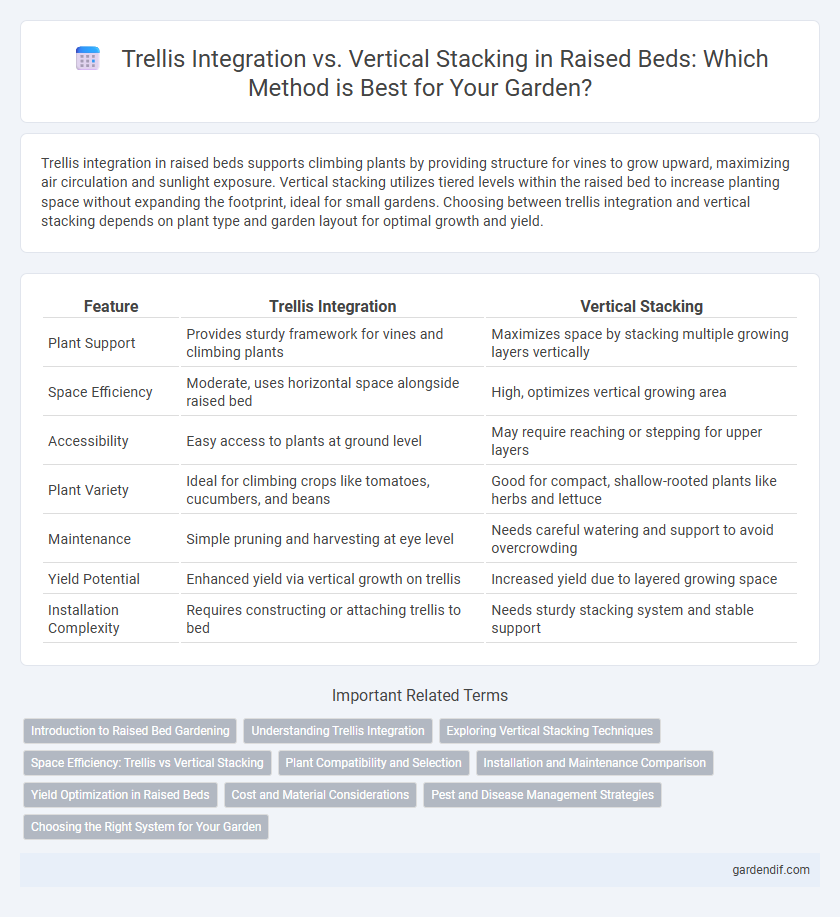
Trellis integration vs vertical stacking Illustration
Trellis integration in raised beds supports climbing plants by providing structure for vines to grow upward, maximizing air circulation and sunlight exposure. Vertical stacking utilizes tiered levels within the raised bed to increase planting space without expanding the footprint, ideal for small gardens. Choosing between trellis integration and vertical stacking depends on plant type and garden layout for optimal growth and yield.
Table of Comparison
| Feature | Trellis Integration | Vertical Stacking |
|---|---|---|
| Plant Support | Provides sturdy framework for vines and climbing plants | Maximizes space by stacking multiple growing layers vertically |
| Space Efficiency | Moderate, uses horizontal space alongside raised bed | High, optimizes vertical growing area |
| Accessibility | Easy access to plants at ground level | May require reaching or stepping for upper layers |
| Plant Variety | Ideal for climbing crops like tomatoes, cucumbers, and beans | Good for compact, shallow-rooted plants like herbs and lettuce |
| Maintenance | Simple pruning and harvesting at eye level | Needs careful watering and support to avoid overcrowding |
| Yield Potential | Enhanced yield via vertical growth on trellis | Increased yield due to layered growing space |
| Installation Complexity | Requires constructing or attaching trellis to bed | Needs sturdy stacking system and stable support |
Introduction to Raised Bed Gardening
Raised bed gardening benefits from trellis integration by maximizing vertical space and improving plant support, especially for vining crops like tomatoes and cucumbers. Vertical stacking, while space-efficient, can limit root expansion and airflow, potentially reducing overall plant health in raised beds. Trellises enhance sunlight exposure and facilitate easier harvesting, making them a superior choice for raised bed setups.
Understanding Trellis Integration
Trellis integration in raised beds enhances vertical gardening by providing structured support for climbing plants, optimizing space without overcrowding. This method improves air circulation and sunlight exposure compared to vertical stacking, reducing disease risk and boosting plant health. Understanding trellis integration enables efficient crop management and maximizes yield in compact garden areas.
Exploring Vertical Stacking Techniques
Vertical stacking techniques maximize space efficiency in raised beds by growing plants upward rather than outward, making them ideal for small gardens and limited areas. Integrating trellises supports climbing plants, enhances air circulation, and increases sunlight exposure, which boosts plant health and yields. Compared to vertical stacking, trellis systems offer more structural support, allowing for heavier or vine-based crops such as tomatoes, cucumbers, and beans to thrive.
Space Efficiency: Trellis vs Vertical Stacking
Trellis integration maximizes space efficiency by allowing plants to grow vertically while maintaining airflow and sunlight exposure, essential for healthy growth. Vertical stacking conserves ground area by layering multiple growing levels but may limit light and air circulation to lower tiers, potentially affecting plant development. For optimal space utilization, trellises suit climbing crops needing vertical support, whereas vertical stacking benefits smaller plants or seedlings where surface area is limited.
Plant Compatibility and Selection
Trellis integration supports climbing plants such as tomatoes, peas, and cucumbers, promoting healthy growth and maximizing vertical space without crowding. Vertical stacking works well for compact, bushy plants like lettuce, strawberries, and herbs, allowing efficient layering but may limit air circulation for taller species. Selecting the right method depends on plant growth habits and space requirements to optimize yield and maintain plant health.
Installation and Maintenance Comparison
Trellis integration in raised beds offers straightforward installation by anchoring support structures directly into the soil, facilitating easy plant training and pruning. Vertical stacking requires assembling modular units, which can increase setup complexity but maximizes space efficiency for dense planting. Maintenance for trellises involves regular tension adjustments and inspections for damage, whereas vertical stacking demands routine stabilization checks and potential soil amendments in stacked layers.
Yield Optimization in Raised Beds
Integrating trellises in raised beds maximizes vertical space utilization, promoting healthier plant growth and higher crop density compared to vertical stacking methods. Trellis systems enhance air circulation and sunlight exposure, reducing disease risk and boosting photosynthesis efficiency for increased yield. Structuring crops vertically with trellises optimizes soil nutrient use and simplifies harvesting, directly contributing to improved yield optimization in raised bed gardening.
Cost and Material Considerations
Trellis integration typically requires fewer materials and lower upfront costs compared to vertical stacking, as it uses lightweight frameworks like wood or metal to support climbing plants. Vertical stacking systems, while maximizing space, often involve pricier components such as modular containers or reinforced structures to bear additional weight. Budget planning should prioritize durability and maintenance expenses in both methods to ensure cost-effective, long-term garden productivity.
Pest and Disease Management Strategies
Trellis integration in raised beds enhances air circulation, reducing the risk of fungal diseases and making pest detection easier compared to vertical stacking. Vertical stacking can create dense foliage that traps moisture, fostering environments conducive to pests like aphids and diseases such as powdery mildew. Effective pest and disease management in raised beds favors trellis structures due to improved sunlight exposure and accessibility for routine inspection and treatment.
Choosing the Right System for Your Garden
Trellis integration offers plants support for climbing, improving air circulation and maximizing exposure to sunlight, which reduces disease risk and enhances yield. Vertical stacking saves space by layering plants, ideal for small gardens or urban settings, but may limit airflow and sunlight for lower layers. Selecting the optimal system depends on plant type, available space, and desired maintenance level to boost garden productivity efficiently.
Trellis integration vs vertical stacking Infographic

 gardendif.com
gardendif.com